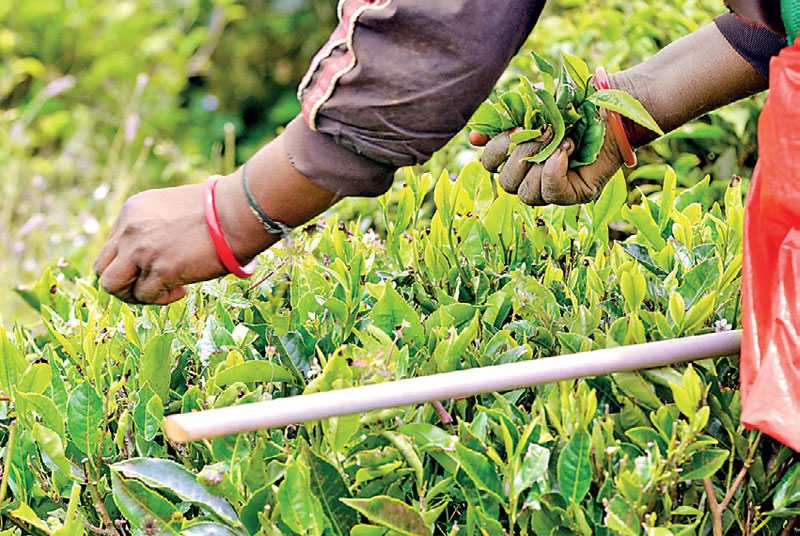Friday Nov 15, 2024
Friday Nov 15, 2024
Thursday, 24 December 2020 00:17 - - {{hitsCtrl.values.hits}}

Tea, Sri Lanka’s largest foreign exchange earning crop, saw difficult times in 2020 with both prices and production dropping
The tea sector weathered a difficult year with revenues slumping by Rs. 12.43 billion to Rs. 209.02 billion while production dropped by 27.3 million kilos to 241.6 million kilos in the first 11 months of 2019, brokers said yesterday, but rupee prices reached an all-time high of Rs. 80 per kilo due to COVID-19 impact.
Following the final auction for the year, which was met with fair demand due to holidays being around the corner, Forbes & Walker Tea Brokers said January-November 2020 cumulative exports totalled 241.6 million kilos, showing a deficit of 27.3 million kilos vis-à-vis 268.9 million kilos of January-November 2019.
“All main categories of exports show a decrease compared to the corresponding period of 2019, with packeted tea showing a fairly substantial decrease. Meanwhile, revenue too of Rs. 209.02 billion has recorded a decrease of Rs. 12.43 b vis-à-vis Rs. 221.45 billion of January-November 2019. Total FOB value, however, of Rs. 865.03 ($ 4.71) shows a gain of Rs. 41.52 when compared to Rs. 823.51 ($ 4.63) of January-November 2019.
Turkey has retained the number one position for Ceylon Tea followed by Iraq and Russia with Iran occupying the fourth position. But there was also a fairly substantial decrease in imports from Iran recorded during January-November 2020 compared to the corresponding period of 2019.
Other noteworthy importers were China, Azerbaijan and Chile. Meanwhile, destinations such as Libya, Japan, UAE and Syria have recorded a fairly significant decrease in imports during the period under review.
Tea exports for the month of November 2020 totalled 20.2 million kilos, showing a decrease of 1.7 million kilos vis-à-vis 21.9 kilos of November 2019.
When analysing the main categories of exports Bulk Tea shows a marginal growth, whilst tea bags and packeted tea have shown a decrease compared to the corresponding period of 2019. Total revenue of Rs. 17.77 billion of November 2020 shows a marginal decrease compared to Rs. 18.29 billion of November 2019. This has resulted in the FOB value of Rs. 879.01 ($ 4.78) of November 2020 showing a gain of Rs. 46.31 vis-à-vis Rs. 832.70 ($ 4.65) of November 2019, the report added.
Tea production for the month of November totalled 24.8 million kilos, showing an increase of 0.8 million kilos vis-à-vis 24.0 million kilos of November 2019. High and mid growns have shown a decrease, whilst low growns show a fairly significant increase compared to the corresponding month of 2019 and largely reflect a recovery after a drought induced decline in 2019.
“January-November 2020 cumulative production totalled 249.9 million kilos, recording a deficit of 28.3 million kilos vis-à-vis 278.2 million kilos of January-November 2019. On a cumulative basis, all elevations have shown a decrease, with low growns showing the highest deficit.”
CTC cumulative production, January-November 2020 totalled 21.37 million kilos, recording a 0.23 million kilo deficit vis-à-vis 21.60 million kilos of January-November 2019. On a cumulative basis, high growns have recorded a fairly significant gain YOY, whilst mediums show a marginal decrease. Low growns, however, have recorded a fairly substantial decrease.
The 50th and final auction for the year concluded yesterday had on offer a total of 6.3 million kilos. There was fair general demand often at easier rates, which perhaps is a combination of higher volumes, lower quality and more importantly, the withdrawal of buying interest due to the post-auction Christmas holiday period.
Ex-estate offerings were similar to last and totalled 0.9 million kilos. Overall quality of offerings showed no significant change, with a limited availability of better liquoring teas.
Best Western BOPs declined Rs. 20-30 per kg and more following quality, whilst the corresponding BOPFs followed a similar trend. In the below best and plainer categories, BOPs were generally firm, whilst the corresponding BOPFs which commenced firm declined Rs. 20-30 per kg as the sale progressed.
Nuwara Eliyas were irregular following quality though still continued to attract premium prices. Uda Pussellawa BOP/BOPFs sold around last week’s levels subject to price fluctuations following quality. Uva BOPs declined Rs. 20 per kg and more following quality, whilst the corresponding BOPFs were Rs. 20-30 per kg lower on last.
High and medium grown CTC teas too followed a similar trend and often declined Rs. 20 per kg and substantially more for the poorer sorts. Corresponding low grown types sold well.
Low growns comprised approximately 2.7 M/Kgs in the leafy/semi leafy and tippy catalogues. There was fair demand. In the leafy/semi leafy catalogues, BOP1/OP1s in general were easier. Few well-made OP/OPAs together with teas at the bottom maintained. All others were lower. Well-made PEK/PEK1s maintained, whilst the others were irregular following quality.
In the Tippy catalogues, FBOPs together with the well-made FF1s maintained, whilst the cleaner varieties in the below best and bottom appreciated. Balance were firm. In the premium catalogue, well-made teas were firm to dearer, whilst the others too were fully firm. However, the leafier varieties were irregular following quality.
